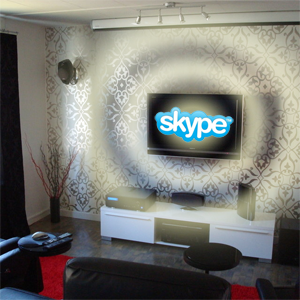 NEWS
NEWS
 NEWS
NEWS
 NEWS
NEWS
![]() Microsoft and Skype sealed the deal today—the most famous and best branded VoIP provider across the Internet will now become a division of the most powerful software house in the world. The future of personal communications may yet have an interesting road ahead of it with the well funded might of Microsoft behind it.
Microsoft and Skype sealed the deal today—the most famous and best branded VoIP provider across the Internet will now become a division of the most powerful software house in the world. The future of personal communications may yet have an interesting road ahead of it with the well funded might of Microsoft behind it.
“Microsoft is committed to the ubiquity of the Skype experience–communication across every device and every platform will remain a primary focus,” said Tony Bates, President of Skype. “And we’ve only scratched the surface. We’re at the starting line of integrating world-class talent, innovative technologies and products. By bringing together the best of Microsoft and the best of Skype, we’ll deliver amazing new experiences for consumers and business around the world.”
The statement about the ubiquity of Skype for devices is extremely interesting to me—and falls right in line with exactly what VoIP provides for communication which is all about communication beyond voice.
Almost all mobile devices nowadays have cameras, some smartphones now have two cameras—one forward facing and one facing the user—we may not quite be at the level of the Dick Tracy watch-videophone but people are becoming a lot more comfortable with having our phones “see” us. Not only that, being able to telepresence another person to where you’re at is a big deal. After all, why just listen to the concert your friend is at when she can hold up the phone and show you the band during the conversation.
The Skype-Microsoft Connection is good for the living room
The biggest deal we’re probably going to see out of the gate with Skype isn’t going to be mobile yet.
It’s probably going to be the integration into Xbox consoles using the Kinect as its camera. We’ve already seen how far and wide that Kinect stretches the usefulness of the gaming console for gaming, but it has so much untapped potential as a communication device or even a teleconference and collaboration device and Skype’s network and setup are a perfect fertile ground to grow that. For millions of homes that don’t have a computer, the Xbox-Kinect setup paves the way for widespread livingroom-to-livingroom video communication.
It’s also the perfect avenue for livingroom-to-mobile communication. And, add on the Kinect ability to translate expressions, people would even be able to project a cartoon avatar of themselves—to hide their bedhead or even diminish the distraction of the railcar they’re standing in—but still maintain the emotion generated by their body language for the person on the other end of the conversation.
Microsoft has pushed far and wide to develop their broad and deep consumer base through their Xbox video game console. They’re also slowly pulling it up into an all-in-one living room media center and Internet experience. The Xbox is deeply embedded in the living room cloud and the personal cloud, meaning that the addition of Skype would probably round it out for every household it’s in.
But what about enterprise Applications?
Here, Microsoft will be hot on the heels of Cisco when it comes to developing and deploying enterprise level applications for voice and video over IP. They’ve already gotten themselves an extremely stable and highly effective technology for capturing video in their video game consoles at the consumer level; it makes sense that they could just go back to the drawing board with the Kinect and develop a business solution to do a very similar thing.
Currently, Skype is heavily used on a personal level and not so much for telepresence or business collaboration; however, with enough of Microsoft’s resources and the addition of networking capability that could provide a broad, stable uptime, it could easily be welded onto an enterprise platform to do just that.
In fact, once again the Avatar Kinect could become a culturally useful collaboration tool at the enterprise level. The collaborators would be able to see each other in simplified “cartoon” forms, separated from the distractions of their cubicle or workplace, sitting around a table with a blackboard/whiteboard that they could all address in real time. Add some sort of document collaboration solution and it has the makings of a virtual reality teleconference solution that could make teams who are miles apart feel like they’re sitting in the same room.
Peanut butter and chocolate at last?
My sweet tooth has been tingling for Skype on the Xbox 360 and the integration of Avatar Kinect for some time now. Video games and living room consoles make a great place for proof of concept and the consumer sector is quite happy to glom onto anything that gives them the ability to express themselves. We’ll probably see the innovations of the Microsoft-Skype deal happen there first.
At this point we’ll just have to wait and see.
Support our mission to keep content open and free by engaging with theCUBE community. Join theCUBE’s Alumni Trust Network, where technology leaders connect, share intelligence and create opportunities.
Founded by tech visionaries John Furrier and Dave Vellante, SiliconANGLE Media has built a dynamic ecosystem of industry-leading digital media brands that reach 15+ million elite tech professionals. Our new proprietary theCUBE AI Video Cloud is breaking ground in audience interaction, leveraging theCUBEai.com neural network to help technology companies make data-driven decisions and stay at the forefront of industry conversations.